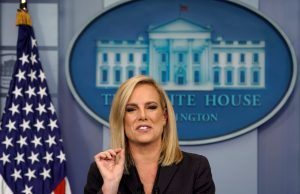
By Patricia Zengerle
WASHINGTON (Reuters) – U.S. President Donald Trump heads to Texas on Thursday to press his case that the country is facing a crisis that can only be solved by spending billions of dollars to construct a wall along the border with Mexico.
His trip to the border town of McAllen, Texas, comes on the 20th day of a partial government shutdown that has left hundreds of thousands of Americans out of work or working without pay, while Trump and fellow Republicans fight with Democrats over his demand for $5.7 billion this year to construct the barrier.
Trump’s plan to build a wall at the southern border was a central promise of his 2016 presidential campaign. He said last month he would be “proud” to shut the government down over the issue but has since blamed Democrats.
He also has been considering whether to declare a national emergency and use it to circumvent Congress by building the wall with money allocated for the Department of Defense. Democrats who control the House of Representatives refuse to approve the wall funding.
Critics say such a move by Trump would be illegal and plan to immediately challenge it in court. Even some Republicans who want to build a wall have said they do not want money to be taken from the military to pay for it.
Trump will travel to Texas with the state’s two U.S. senators, Republicans John Cornyn and Ted Cruz. After Trump’s midday visit, Cornyn will host a roundtable discussion with area mayors, judges, law enforcement personnel and others involved with the border issue.
On Dec. 22, about 25 percent of the government – excluding mainly the Department of Defense and health-related programs – shut down because of Congress’ inability to complete work by a September deadline on funding all government agencies.
Backed by most Republicans in Congress, as well as his most ardent supporters, Trump has said he will not sign any bill to reopen the government that does not provide the funds he wants for the wall.
“There is GREAT unity with the Republicans in the House and Senate, despite the Fake News Media working in overdrive to make the story look otherwise,” Trump tweeted on Thursday ahead of his departure. “The Opposition Party & the Dems know we must have Strong Border Security, but don’t want to give ‘Trump’ another one of many wins!”
ACRIMONIOUS MEETING
The impasse has continued while Trump’s meetings with Democratic congressional leaders have ended in acrimony. On Wednesday, he stormed out of a meeting with House Speaker Nancy Pelosi and Senate Democratic leader Chuck Schumer, calling it “a total waste of time.”
Trump says undocumented immigrants and illegal drugs are streaming across the border from Mexico, despite statistics that show illegal immigration there is at a 20-year low and that many drug shipments likely are smuggled through legal ports of entry.
Democrats accuse Trump of using fear tactics and spreading misinformation about the border situation in order to fulfill a 2016 campaign promise as he looks toward his race for re-election in 2020.
The president has been working to make his case to the public, and bolster any congressional Republicans who might be wavering.
Pressure on them could intensify on Friday when about 800,000 federal employees – including border patrol agents and airport security screeners – miss their first paychecks.
On Tuesday, Trump said in his first prime-time television address from the Oval Office that there was a growing security and humanitarian crisis at the border.
On Wednesday, he visited Republican lawmakers at the U.S. Capitol, emerging from a meeting to say his party was “very unified.”
Less than two hours later, eight Republicans in the House voted with majority Democrats on a bill that would reopen the Treasury Department and some other programs and did not include any funding for the wall.
Republican Senate Majority Leader Mitch McConnell has made clear, however, that he will not allow that chamber to vote on any measure that does not include wall funding.
(Reporting by Patricia Zengerle; Additional reporting by Susan Heavey; Editing by Peter Cooney and Bill Trott)




